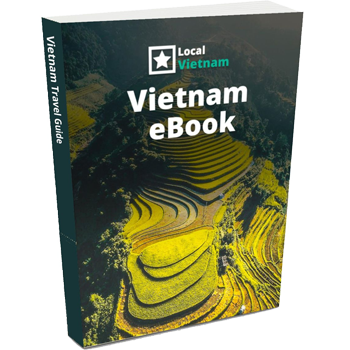What is Thieu Tri Tomb?
The Tomb of Thieu Tri is the royal mausoleum of Vietnam’s third Nguyen emperor, located just outside of Hue. Unlike the grander tombs of his father Gia Long or his son Tu Duc, this site is known for its quiet setting and more modest layout. It’s one of several imperial tombs in Hue, a former royal capital where the Nguyen Dynasty ruled from 1802 to 1945, leaving behind a legacy of temples, palaces, and historic graves.
Who was emperor Thieu Tri?
Emperor Thieu Tri (1807–1847) was the son of Emperor Minh Mang and the third ruler of the Nguyen Dynasty. He reigned for just seven years, a relatively short period marked by continuity rather than major reform. Like his father, he upheld Confucian values and maintained Vietnam’s resistance to Western influence, especially French missionaries. Thieu Tri was known as a scholarly and conservative ruler who preferred poetry, traditional governance, and stability. He died unexpectedly in 1847, leaving his son Tu Duc to succeed him as emperor.
History of Thieu Tri Tomb
The Mausoleum of Emperor Thieu Tri was built shortly after the emperor’s sudden death in 1847 and completed the following year by his son, Emperor Tu Duc. Unlike other Nguyen emperors, Thieu Tri did not plan his own tomb during his lifetime, which may explain the site’s simpler layout and faster construction. The location—just a few kilometers west of Hue—was chosen for its natural setting between rice fields and low hills, offering a quiet, open landscape rather than a forested mountain backdrop.
One interesting aspect is that this is the only royal tomb in Hue not surrounded by protective walls, which reflects the emperor’s modest personality and possibly the rushed timeline. Despite its simplicity, the tomb still follows the traditional principles of feng shui and axis-based layout seen in other Nguyen mausoleums. Over time, the Tomb of Emperor Thieu Tri has remained one of the least visited imperial tombs in Hue, giving it a peaceful, untouched feel compared to its more elaborate counterparts.
Highlights & architecture
The Tomb of Thieu Tri has a unique structure that sets it apart from other royal mausoleums in Hue. Instead of one central axis like most Nguyen tombs, it features two parallel axes—one for the worship area and one for the tomb area. These axes run side by side, dividing the site into two distinct sections: the left side is for ceremonial worship, while the right side leads to the emperor’s actual resting place. The design remains aligned with traditional feng shui principles, but the layout feels more open and less formal. Here’s what you’ll discover during your visit:
1. Dien Lake
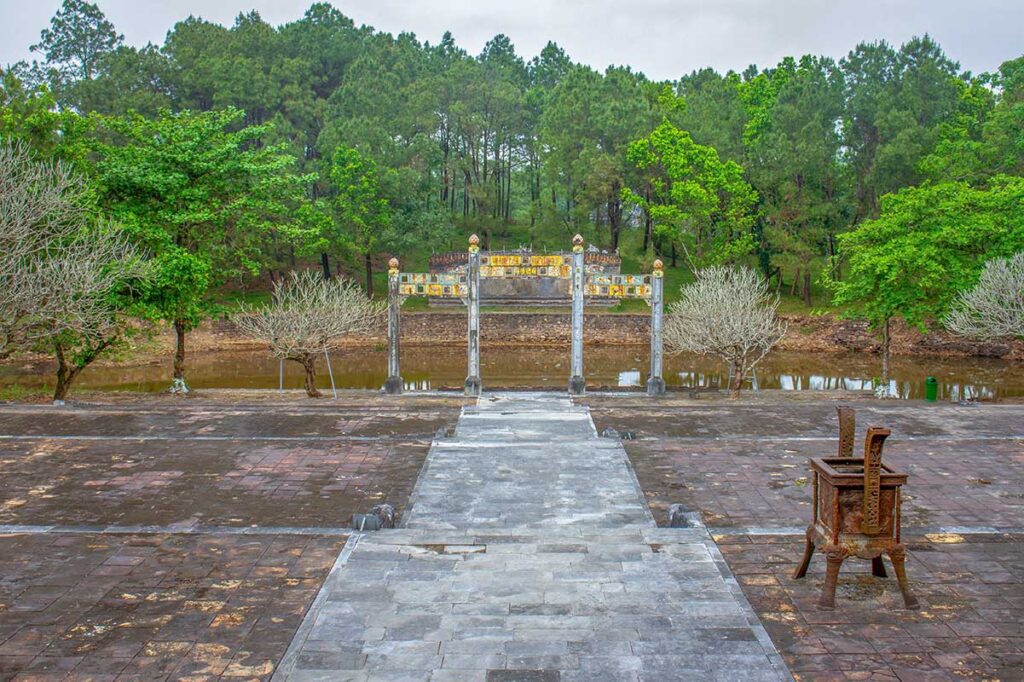
Your visit to the worship area begins at Dien Lake, a peaceful crescent-shaped pond that reflects the classic feng shui design found in many Nguyen tombs. It provides a natural, serene foreground to the rising terraces of the ceremonial zone and sets the tone for the more formal structures that follow.
2. Hong Trach Mon (Tam Quan Gate)

At the top of a series of stone steps stands Hong Trach Mon, the main inner gate of the worship complex. Built in traditional tam quan style, it features three arched doorways—symbolizing the division between the spiritual and earthly worlds—with the central gate reserved for the emperor’s spirit. With its red-tiled roof and two-level structure, it feels both stately and understated. Walking through this gate brings you into the main worship courtyard.
3. Bieu Duc Temple
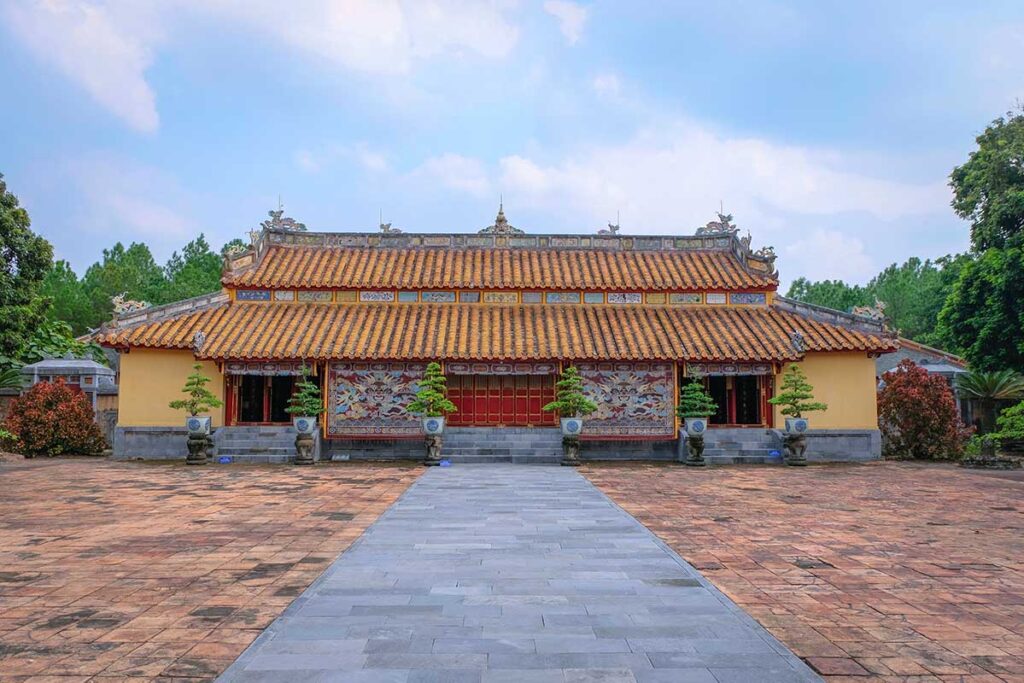
This is the spiritual centerpiece of the worship area, where Emperor Thieu Tri and Queen Tu Du are honored. The temple is built in a classic double-roofed style, with red lacquered wooden pillars and a roof decorated with dragons and intricate relief carvings. Inside, you’ll find 450 carved poems and the ancestral tablets of the emperor and empress. The quiet setting and incense scent give it a truly reflective atmosphere.
4. Nhuan Trach Lake & Tomb Area Gate
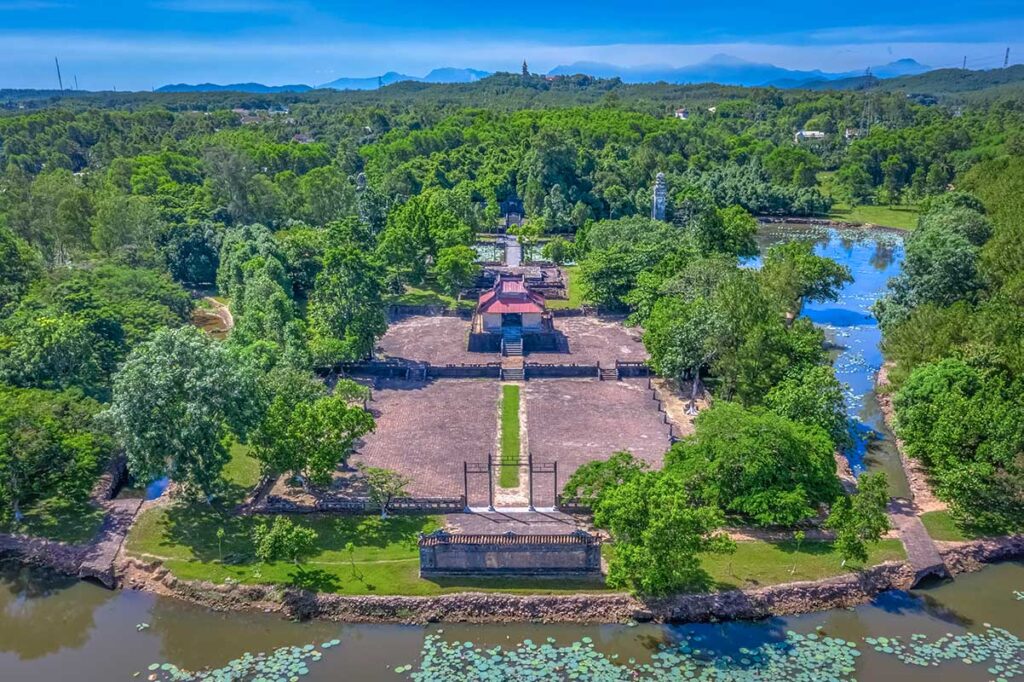
On the right-hand side of the complex lies the tomb area, beginning with another crescent-shaped pond called Nhuan Trach Lake. A second three-door gate, this time made of copper, marks the entrance. The design mirrors the worship side, keeping the balance between ceremony and final rest.
5. Bai Dinh Yard & Stone Statues
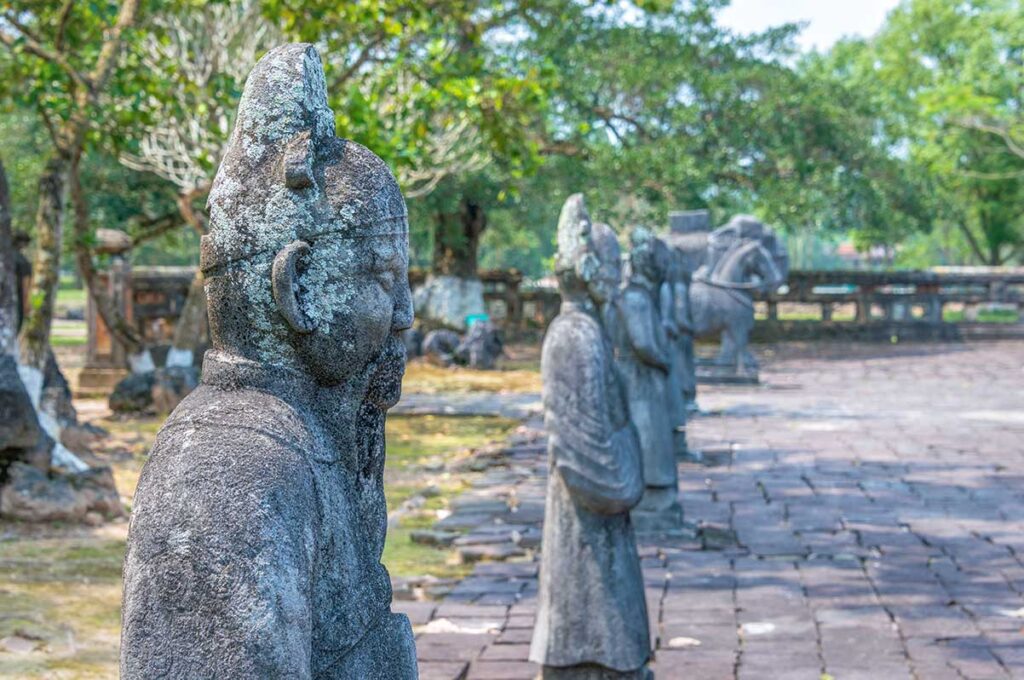
Behind the gate is Bai Dinh Yard, a wide brick courtyard flanked by rows of stone statues—mandarins, elephants, and horses. These symbolic guardians represent the emperor’s loyal subjects in the afterlife and are a classic feature of royal tombs in Hue. The quiet symmetry of the space adds to its solemn feel.
6. Stele Pavilion (Bi Dinh)
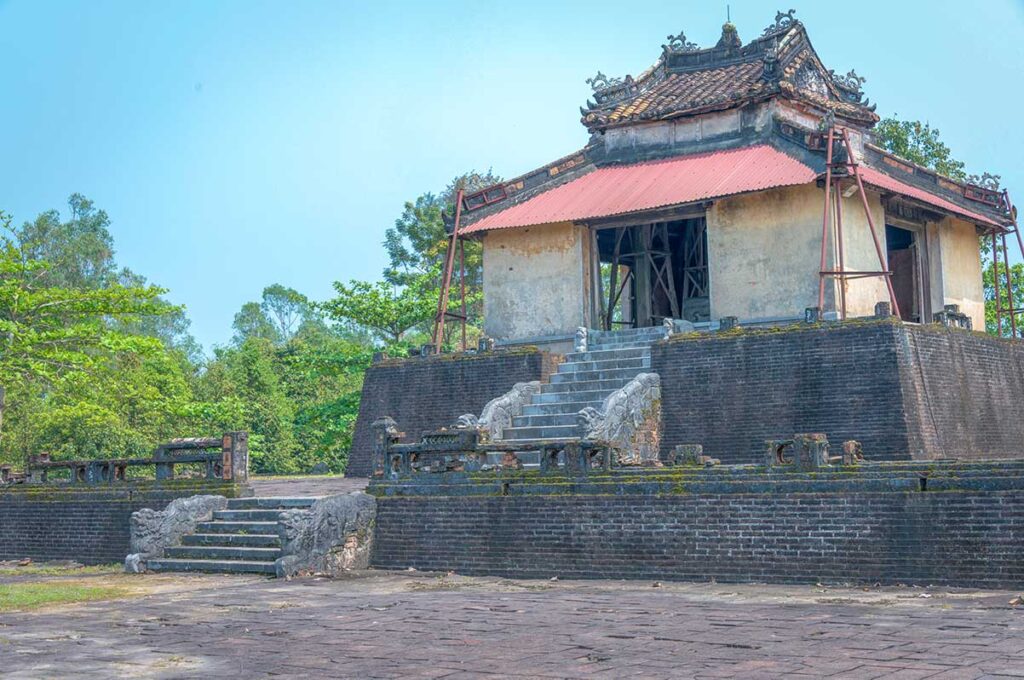

At the end of the courtyard stands the Bi Dinh, a small square pavilion housing a stone stele titled “Thanh Duc Than Cong.” The inscription, written by Emperor Tu Duc, contains more than 2,500 Chinese characters praising his father’s life and virtues. It’s one of the key historical artifacts in the tomb.
7. Duc Hinh Lau (Now Ruins)
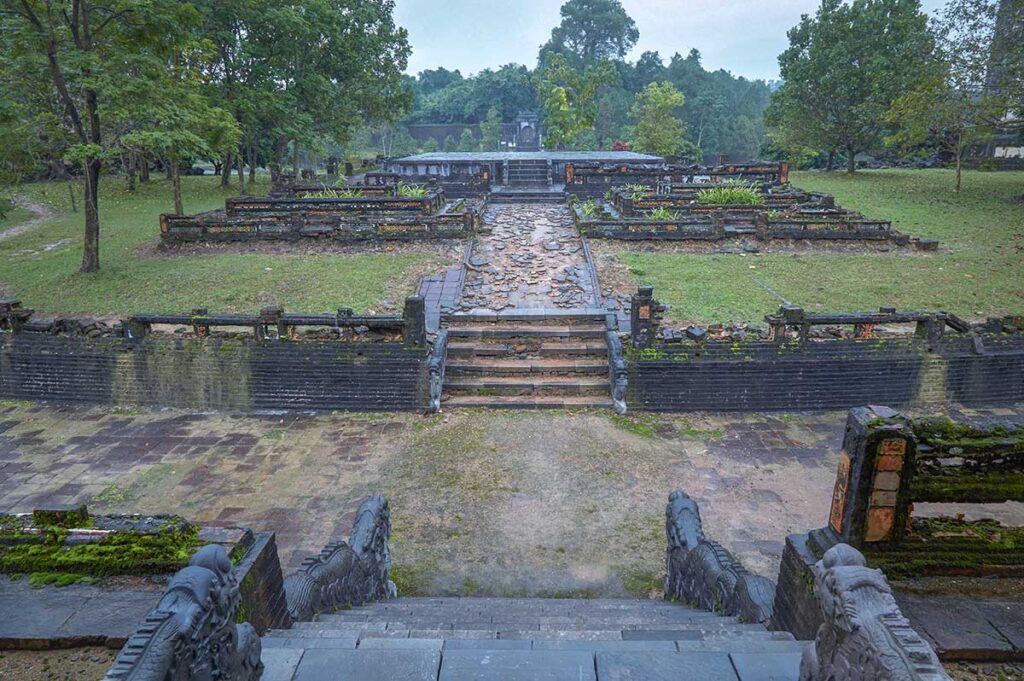
Just beyond the stele pavilion are the remains of Duc Hinh Lau, once a viewing platform or ceremonial structure. Today, only its stone foundation remains, but it still marks the central point of the tomb’s axis.
8. Flower Garden & Ngung Thuy Lake
A simple but elegant garden stretches behind the pavilion, divided into two symmetrical halves. At the end lies Ngung Thuy Lake, crossed by three stone bridges—Dong Hoa, Tay Dinh, and the central Chanh Trung Bridge. The bridges are aligned with the tomb and symbolize the final passage toward the afterlife.
9. Buu Thanh (Grave Area)
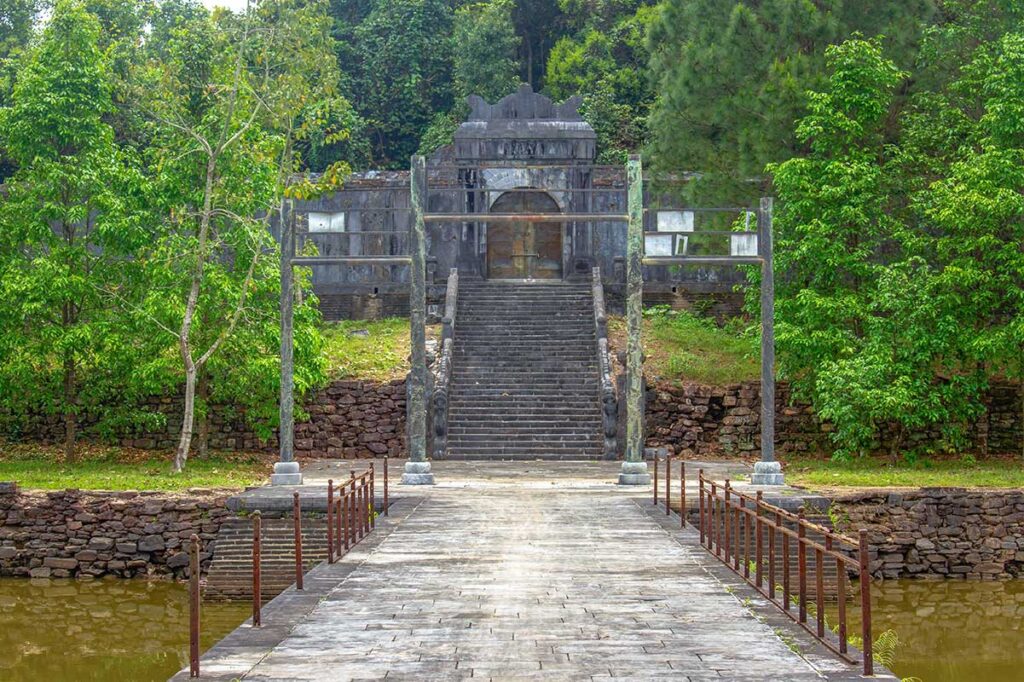
Crossing the bridge brings you to Buu Thanh, a round stone wall enclosing the emperor’s grave. It sits on a low hill surrounded by old trees, giving the area a quiet, natural atmosphere. This part of the Mausoleum of Emperor Thieu Tri is less ornate than other royal tombs, but it has a calm, respectful presence that many visitors find deeply moving.
Visiting information & Practical tips
Location
The Tomb of Thieu Tri is situated in Cu Chanh Village, Thuy Bang Commune, Huong Thuy District, approximately 8 kilometers southwest of Hue’s city center. Nestled amidst tranquil rice fields and gentle hills, the tomb offers a serene escape from the bustling city.
Entrance fee
- Adults: 50,000 VND
- Children: Free of charge
Tickets can be purchased directly at the entrance.
Opening times
- Daily: 07:00 AM – 05:00 PM
The tomb is open every day, including public holidays.
Dress code
While there’s no strict dress code, visitors are encouraged to dress modestly out of respect for the cultural and historical significance of the site. Lightweight clothing that covers shoulders and knees is recommended, especially considering the warm climate.
Guides
Exploring the Mausoleum of Emperor Thieu Tri independently is straightforward, thanks to its compact layout. However, informational signage is limited. Hiring a local guide can provide deeper insights into the emperor’s life, the tomb’s symbolism, and its unique architectural features, enriching your visit.
Nearby sights
While the Tomb of Thieu Tri is somewhat secluded, there are several noteworthy sites in the vicinity:
- Dong Khanh Tomb: Located nearby, this tomb is known for its blend of Eastern and Western architectural styles.
- Tu Duc Mausoleum: Situated in the same general area as Dong Khanh Tomb, it’s renowned for its poetic ambiance and intricate design.
- Thuy Tien Lake (Abandoned Waterpark): Approximately 3.5 kilometers from Thieu Tri Tomb, this eerie yet fascinating site features a massive dragon structure and has become a popular spot for adventurous travelers.
- Khai Dinh Tomb: A bit further afield, this tomb stands out for its elaborate fusion of Vietnamese and European architectural elements.
How to get to the Tomb of Thieu Tri?
The Tomb of Emperor Thieu Tri is located in a quiet rural area outside Hue, and while not far in distance, it’s not as well-connected as more popular sites. Here are the best ways to reach it:
Taxi or grab app
Taking a taxi or using the Grab app is the most convenient option if you prefer door-to-door transport. The journey from Hue city center takes around 20–25 minutes, and a one-way fare typically ranges from 150,000–200,000 VND.
- Grab works like Uber and is available in Hue. You can book either a car or a motorbike through the app, and the fare is shown before you confirm the ride.
- It’s a good idea to ask the driver to wait while you visit, as it can be difficult to find another ride back in this quiet area.
Cycling or scooter
For travelers looking for a more flexible or adventurous option, renting a bicycle or scooter is a great way to reach the tomb.
- Cycling takes around 45–60 minutes from the city center. The road is mostly flat and passes through peaceful countryside, but bring water and sun protection.
- Scooters can be rented easily in Hue and allow you to combine your visit with nearby sights like Dong Khanh or Tu Duc Tomb. Just be aware of local traffic conditions.
Private Tour
Since the Mausoleum of Emperor Thieu Tri is not included in most standard group tours, your best option is to book a private tour.
A private tour gives you full control over your itinerary and allows you to include lesser-visited sites like this one. You can combine it with nearby tombs, countryside stops, or even lesser-known places like the abandoned waterpark. A local guide can also provide deeper insights into the tomb’s history and structure.
More historical sights in Hue
Besides the Tomb of Thieu Tri, Hue is home to many other important historical landmarks from the time of the Nguyen Dynasty, Vietnam’s last imperial family. These include royal tombs, temples, and the remains of the imperial capital. Exploring several sites together gives you a deeper understanding of Hue’s role in Vietnamese history.
- Thien Mu Pagoda – Overlooking the Perfume River, this is one of Hue’s most iconic religious sites. Known for its tall octagonal tower and peaceful atmosphere, it remains an active Buddhist monastery and a symbol of the city.
- Hue Imperial City – A large walled citadel in the city center that once served as the political and ceremonial heart of the Nguyen Dynasty. It includes ancient gates, palaces, temples, and a royal theater, with ongoing restoration projects bringing parts of it back to life.
- Tu Duc Tomb – A peaceful and poetic royal tomb designed as both a retreat and final resting place. Known for its tranquil setting, lotus ponds, and elegant pavilions, it reflects the emperor’s love for nature and poetry.
- Minh Mang Tomb – Famous for its perfect symmetry and scenic location, this tomb blends architecture with nature in a highly structured layout. It’s one of the most visited tombs in Hue and offers a classic example of imperial feng shui design.
- Khai Dinh Tomb – A striking contrast to the others, this tomb is built on a hillside and combines Vietnamese and European architectural styles. Its elaborate mosaics and dramatic staircases make it one of the most unique royal mausoleums in Vietnam.

